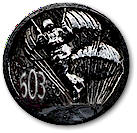|
Headquarters
503d Parachute Infantry
26 Oct. 1943
SUBJECT : Report of Encounter with Enemy Forces.
TO : The Adjutant General, U.S. Army, Washington D.C.
In compliance with paragraph 10, AR 345-105, dated 18 November 1929, the following report of the Parachute activities in operation
against Japanese forces in the Markham Valley, 5 September 1943
to 19 September 1943, is hereby submitted.
1. General
: The 503d Parachute Infantry was employed in conjunction with the
7th Australian Division and the 9th Australian Division in an air-sea and ground offensive
against Japanese forces in the Markham Valley, New Guinea 5 September 1943
to 19 September 1943. The mission of the 503d Parachute Infantry was to seize the
Nadzab E/L Strip and prepare it for use in landing of Airborne Australian
troops and to close the western inland approaches of the Markham valley.
2. Departure
: Due to the splendid co-operation of the Fifth Air Force and the 54th Troop Carrier
Wing, all departures were effected smoothly. All planes had been properly
fitted for parachute drops, viz, doors taped and all excess accoutrements
removed from the interior prior to arrival of the troops.
The troops arrived at the airfield and were at their
assigned planes two hours prior to take-off. During this period,
parachutes and equipment were fitted an the individuals. Fifteen (15)
minutes prior to take-off, all men were seated in the planes with
parachutes and full equipment on.
At 0825 hours, 5 September, the take-off was started.
The rendezvousing of the eighty-tow (82) transports required forty-five
(45) minutes. When all elements were in formation, the flight to the drop
area was started.
3. FLIGHT AND DROP : The flight was flying
three (3) battalion columns in a formation of six (6) planes echeloned to
the right rear and thirty (30) seconds between elements. After flying for
one (1) hour, the first check point (Tsili-Tsili) was passed. At this
point, all men were stood up in the plane and equipment checked. Twelve
(12) minutes later, the Markham River, the second check point, was passed and the men stood in the
door. In three (3) minutes the troops were jumping and in four and
one-half (4½) minutes, eighty-one (81) transports were emptied. Each
battalion landed on their assigned jump fields and proceeded immediately
to their assembly areas.
4. GROUND ACTION : The ground action
proceeded as planned. The 1st battalion, 503d Parachute
Infantry seized the Nadzab E/L Strip and commenced its preparation to
receive airborne troops. The 2d and 3d Battalions, blocked all approaches
from the North and East and established a network of extended patrolling.
Very little activity was encountered. The 2/2 Australian Pioneer
Battalion joined the 1st Battalion at 1800 hour, 5 September 1943, to take over the preparation of the strip. The original strip
was 1500 feet long and had remained unused for twelve (12) months. This
strip was improved and extended to 3300 feet. The 1st
battalion then set up a perimeter defense around the strip to protect the
2/2 Australian Pioneer Battalion and the natives working with them. The
Airborne troops, in C-47 airplanes, began to land at 1000hour, 6 September 1943, 23½ hours after the jump was made.
On 8 September 43, the 25th Australian Brigade had arrived and had
replaced our 3d Battalion who were then withdrawn to the vicinity of the
strip.
The Australians continued their push down the Valley
and on 14
September 43, the 3d Battalion was sent forward to protect their L of C and
to prevent enemy infiltration to their rear. The main body of the
Japanese Forces had at this time evacuated LAE and were withdrawing to the
Northwest. This body encountered the 3d Battalion at 0600 hour, 15 September 43, and the Battalion immediately set up a defensive position to
prevent their breaking through. A detailed account of this action is
attached herein as Inclosure # 2.
The vigorous and aggressive patrol action of this unit
resulted in a few encounters with enemy patrols. The Japanese patrols
always withdrew and in several instances, large amounts of equipment was
abandoned.
5. EVACUATION: a.
The 1st
Battalion was evacuated by air to Port Moresby on 14 September 43
after the arrival of the 225th Australian brigade with
instructions to prepare for another mission.
b. The 2nd Battalion and regimental
Headquarters Division was evacuated on 17 September 43.
c. The 3d Battalion was evacuated on 19 September 43.
6. MISCELLANEOUS : a. The morale of the men was
excellent. The general attitude was one of determination. The men were
disappointed in that they had been ordered not to be used were Infantry
could be employed and were required to remain behind while the Australians
pushed down the Valley.
b. One (1) plane load of fifteen (15) men did
not jump because the crew chief was taking off the door, it blew out and
was hanging on the side of the plane. It would have endangered the life
of every man who would have tried to jump.
c. One (1) man did not jump as he fainted when
the men were preparing to jump. No man refused to jump on this mission.
7. RESULT: a. The prescribed mission
assigned to the 503d Parachute Infantry was carried out most successfully.
b. The casualties were as follows :
Killed in action - Eleven (11)
Wounded in action - Forty-three (43)
|

![]()

